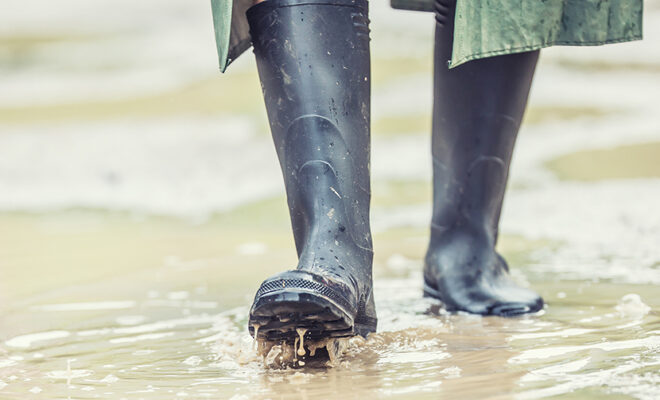Extreme weather is expected to increase the frequency and intensity of rain storms in the Northeastern US. Where will all of this water go and what impact will it have on us?
Understanding the water cycle is foundational to understanding the challenges of flooding in cities like Philadelphia and in developing strategies to enhance resilience. This unit delves deep into the hydrologic cycle, unraveling its complexities and exploring the pathways water traverses our city. Students will learn how extreme weather is causing flooding events to occur more often in Philadelphia. The narrative of the unit is consistent with a specific focus on Philadelphia, including a lesson on the combined sewage water system that is largely impacting flooding events in the city. Students will discuss how the impacts of flooding include environmental, physical health, mental health and economic challenges to communities. The unit concludes with a positive look toward the future as students develop resilience strategies to be used in addressing future flooding. This unit guides students through the nexus of water, extreme weather, and resilience, equipping them with the knowledge and tools to navigate the complexities.
In lesson one, students will learn the process of the hydrologic cycle, the continuous circulation of water on the Earth and in the Atmospheric system. Water moves from the ground to the atmosphere and back to the ground through various processes, most importantly, evaporation, transpiration, condensation, precipitation and runoff. A basic explanation of each process along with images of the water cycle is found at the National Oceanic and Atmospheric Administration website. Evaporation of water from earth’s surface, such as the ocean begins the water cycle. Evaporation changes the liquid state of water into the gaseous state, water vapor. As the water vapor rises through the atmosphere, the water vapor cools and condenses to form clouds. The water vapor remains in the atmosphere until the clouds become too heavy, causing the water vapor to turn to liquid (rain) or solid (snow) and return to Earth’s surface as precipitation. Once water returns to the surface, it can either be evaporated or penetrate the surface to become groundwater, or run-off into surface water like streams, lakes, and rivers. Groundwater and surface water either travels to meet oceans, rivers and streams, or is released back to the atmosphere through transpiration, the evaporation of water from plants.
In lesson two, students will learn what happens when water hits the ground, beginning with an introduction to watersheds. A watershed is an area of land that channels rainfall and snowmelt to bodies of water such as streams, rivers and creeks until eventually flowing to outflow points such as the ocean, reservoirs or bays. The term watershed is interchangeable with drainage basin, which helps to envision a watershed as a bowl where water at the high points will flow to the lowest points of the bowl and can be visualized by the NOAA explanation and diagrams. The lesson continues to explain the difference between water landing on previous and impervious surfaces. Permeable surfaces allow water to seep into the ground while impervious surfaces are solid, do not allow water to penetrate and instead force water to run off. Examples of impervious and pervious surfaces are included at Permeable vs Impermeable. As water flows across Earth’s surface, it collects pollutants which can be dangerous to humans. Students will learn how water flowing throughout Philadelphia on largely impervious surfaces collects pollutants that contaminate the water.
In lesson three, students will learn what happens to water that lands on the surface in Philadelphia. The increase in flooding in Philadelphia is two parts: first, extreme weather is increasing precipitation, and second the combined sewer system of Philadelphia is not equipped to handle the intense precipitation events. Extreme weather is impacting the water cycle largely through the warming of the atmosphere which has caused sea level rise, droughts and increased precipitation. The United Nations provides an overview of extreme weather, including the causes and impacts. The warmer temperatures resulting from extreme weather are causing more water to evaporate from the surface. Due to more water in the atmosphere there is more water returning to the surface. The EPA and National Geographic provide an explanation of how extreme weather is increasing precipitation and therefore increasing flooding events. After discussing the reasoning for why we are experiencing more rainfall , the students will learn where the water goes once it lands on the surface. Philadelphia has a combined sewer system which means that sewage from homes and wastewater from streets enter the same pipes to be sent to the wastewater treatment plant. The system is fine until there is too much precipitation and run-off, causing the wastewater treatment plants to be overwhelmed. As a result, wastewater spills over into the waterways untreated.
In lesson four, students will learn about the impacts of flooding. Repeated flooding impacts infrastructure, human health and the environment. Through a story about a family impacted by flooding and a sorting activity, students will learn about the environmental impacts of flooding including habitat destruction, erosion, water pollution, contaminated soil, and displacement of species. Examples of impacts to infrastructure include damage to roads and bridges from erosion, debris carried by floodwaters damaging buildings or blocking drainage systems and roads, power outages from damaged electrical systems, flooding inside buildings leading to mold growth, and weakened foundations. Impacts on physical health include, respiratory problems resulting from mold growth, waterborne disease, injuries from debris and navigating waters, exposure to chemical contaminated water, and vector-borne diseases brought by insects drawn to moist locations. The Federal Emergency Management Agency provides examples of the impacts of flooding along with data to help conceptualize the dangers of flooding. The physical damages to the environment, infrastructure and physical human health are often represented; however, repeated flooding has significant impacts on an individual’s mental health.
In the final lesson, students will learn resilience strategies that can be used to prepare for and fight against urban flooding. A resilience strategy is a plan to enhance, withstand, adapt to and recover from disruptions or crises. Many resilience strategies to address flooding connect back to lesson two in which students learn how impervious surfaces found in cities contribute to flooding. Replacing the impervious surfaces with green infrastructure such as street trees, permeable pavement, rain gardens, and rainwater harvesting helps allow rainwater to be absorbed rather than runoff the surface and overwhelm the sewer system. By adapting resilience strategies, urban communities can be better prepared for and mitigate the impacts of flooding, protecting people, property, and the environment.



